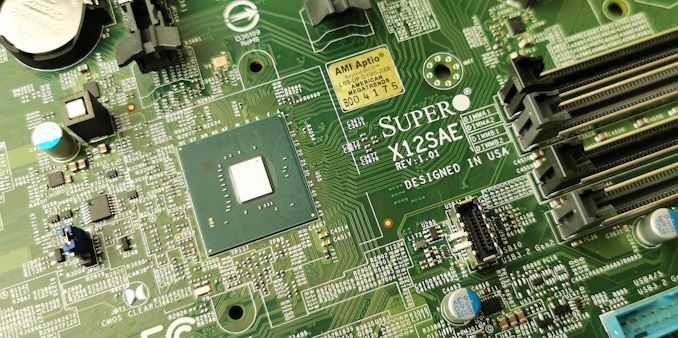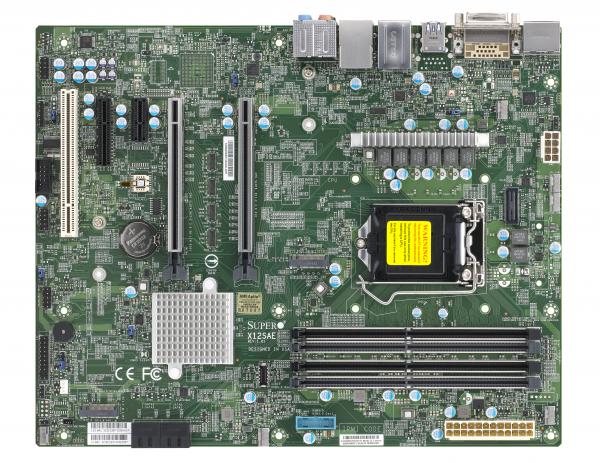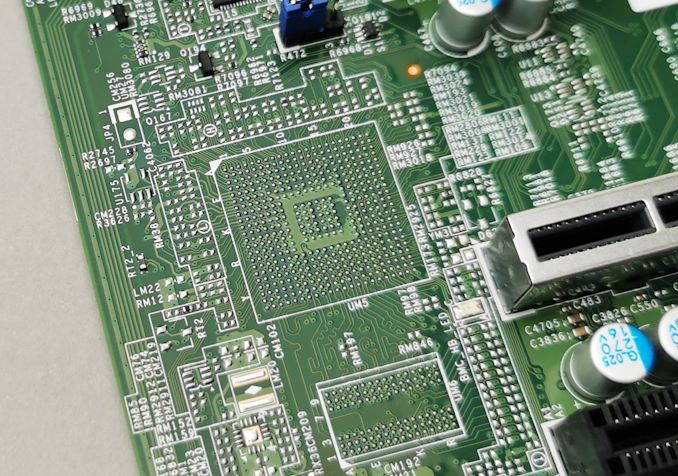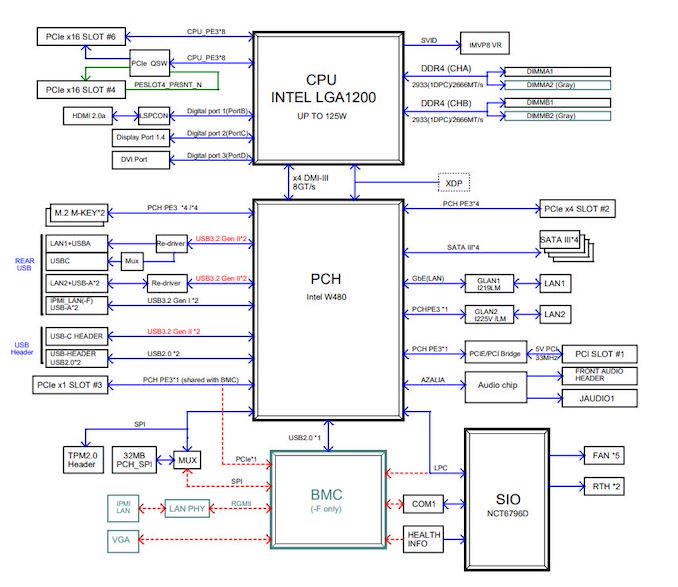Supermicro X12SAE W480 Motherboard Review: For Xeon W-1200 Workstations
by Gavin Bonshor on December 11, 2020 9:30 AM EST
We have seen numerous Intel Z490 motherboards over the months since Intel's platform for Comet Lake was announced back in April. While the Z490 is designed for regular consumers and gamers who intend to use the desktop Intel Core i5/i7/i9 processors, Intel also launched its W480 chipset slightly later which is designed for its workstation orientated Xeon W-1200 series. One such board designed specifically for the Xeon W-1200 processors is the Supermicro X12SAE with support for up to 128 GB of DDR4-2933 of ECC and non-ECC UDIMMs. Also included in the feature set are two PCIe 3.0 x4 M.2 slots, dual Ethernet including a 2.5 Gigabit controller, as well as a dedicated Intel PHY with Intel AMT and vPro support.
Supermicro X12SAE Overview
For every current W480 model on the market, there are at least 4-5 Z490 variants, which makes Intel's workstation platform slim pickings for choice. One of the reasons behind this is down to necessity, with workstations platforms opting for functionality and core feature sets over bling and fancy designs. What the Supermicro X12SAE lacks in visual appeal, it makes up for in its feature set with much of what we have come to expect from its mid-level professional models. The X12SAE is the only conventional ATX sized model from a trio we looked at when we overviewed the W480 chipset earlier on in the year, and as such, has a lot of features included on its green and basic looking PCB. This unit is designed for mass workstation deployment, rather than aesthetics.
Included in the specifications is a pair of PCIe 3.0 x4 M.2 slots, with drives in both M.2 2280/22110 form factors supported. The X12SAE has a total of four SATA ports with support for RAID 0, 1, 5, and 10 RAID arrays, with dual LAN on the rear panel, one 2.5 GbE controller, and the other via an Intel Gigabit PHY. The glaring difference between the LGA1200 Z490 and W480 chipsets supports ECC memory, albeit unbuffed, with the X12SAE allowing for up to 128 GB of DDR4-2933 across four memory slots. For expansion cards, Supermicro includes three full-length PCIe 3.0 slots operating at x16 and x8/x8/+x4, with one PCIe 3.0 x1 and a single 5 V PCI 5 V 32bit slot.
While there is space on the board for a BMC chip, as shown by the pads above, this model does not have it - users should look to the X12SCA-F for a BMC.
On-board audio is quite standard for a board of this caliber as it uses a decent yet aging HD audio codec, with other rear panel connections including a trio of video outputs consisting of an HDMI, DisplayPort, and DVD-D port. There's also USB aplenty, with support for up to five USB 3.2 G2 ports (four rear panel, one internal), with Type-A and Type-C, as well as three USB 3.2 G1, and two USB 2.0.
Supermicro X12SAE Block Diagram
Comparing the Supermicro X12SAE paired with an Intel Xeon W-2170 processor with the rest of the LGA1200 models we've tested so far, albeit, with an Intel Core i7-10700K (closely matched), we saw the expected levels of performance. In our system tests, we saw lower power consumption overall, which can be attributed to a lower TDP and lower threshold for increase power requirements without much of the jazzy bells and whistles of desktop models. We also saw slow POST times, which is a trait generally associated with workstation and server models. DPC performance out of the box was average yet acceptable. In our computation tests, our W-1270 performed as well as expected, despite the power allowance differences compared to the Core i7-10700K. It should be noted that the Intel Xeon range isn't designed for gaming and the high-burst performance of the Core series of Comet Lake processors makes them superior for tasks such as gaming when compared to the Xeon range.
It should be noted that we experienced a number of issues with the X12SAE, including memory support, a dodgy thermal sensor, and intermittent networking dropouts. Details are over the next few pages.
The Current Intel Xeon W-1200 (Comet Lake) Product Stack
The Comet Lake based Intel Xeon W-1200 processors include much of the same technologies as its desktop counterparts, with extra single-core performance through Intel's Thermal Velocity Boost and Turbo Boost Max 3.0. This pushes one core much further than others for a prolonged period of time. In total, there are three main models, including the W-1250, W-1270, and W-1290, each with two or three variations, including the P SKU's, with the P meaning performance.
| Intel Xeon W-1200 Series Processors Comet Lake (LGA 1200/W480) |
|||||||
| AnandTech | Cores | Base Freq (GHz) |
Turbo One Core |
Turbo All Core |
L3 Cache | TDP (W) |
Price ($) |
| W-1290P | 6/12 | 3.7 | 5.3 | 4.9 | 20 MB | 125 | $539 |
| W-1290 | 6/12 | 3.2 | 5.2 | 4.7 | 20 MB | 80 | $494 |
| W-1290T | 4/8 | 1.9 | 4.7 | 3.8 | 20 MB | 35 | $494 |
| W-1270P | 6/12 | 3.8 | 5.1 | 4.7 | 16 MB | 125 | $428 |
| W-1270 | 4/8 | 3.4 | 5.0 | 4.7 | 16 MB | 80 | $362 |
| W-1250P | 6/12 | 4.1 | 4.8 | 4.5 | 12 MB | 125 | $311 |
| W-1250 | 6/12 | 3.3 | 4.7 | 4.4 | 12 MB | 80 | $255 |
The standard variants include an 80 W TDP, with the P models matching the desktop models at 125 W, with a single T model, the W-1290T with a much lower TDP of 35 W. All of these SKUs include integrated graphics, with support for dual-channel ECC memory, and added security built-in via Intel Hardware Shield.
Putting the WORK into Workstation
Rounding back to the Supermicro X12SAE, it should cost around the $280 mark dependant on the retailer, although Newegg, via a third-party seller, has it listed for $350 at present. Currently, there's not a great deal of competition within the W480 boards on the market, but the GIGABYTE W480 Vision W ($260) is a nice price but resembles a more consumer-focused desktop design and feature set. It certainly doesn't offer the flexibility of remote access and real-time monitoring as the Supermicro. It instead goes for upgraded audio, more SATA. It is a desktop board posing as a workstation board instead of focusing on the professional elements associated with a platform such as W480.
Read on for our extended analysis.













55 Comments
View All Comments
Operandi - Friday, December 11, 2020 - link
**meant to reply here**Point being why even review this in the context of a world where the platform AMD exists? From a feature and performance stance AMD is better on both. Unless there is something Supermicro has that other board vendors don't as I don't think Supermicro has a "workstation" AM4 board but still, so what...
Oxford Guy - Friday, December 11, 2020 - link
Products deserve reviews even if the reviews show them to be less compelling versus the competition. For a general audience, the competitiveness factor should be mentioned. For more niche audiences it's not necessarily necessary.Jorgp2 - Sunday, December 13, 2020 - link
>Point being why even review this in the context of a world where the platform AMD exists?AMD exists?
Last time i checked there were only two AM4 workstation boards, and they're both made by supermicro.
Oxford Guy - Tuesday, December 15, 2020 - link
"Last time i checked there were only two AM4 workstation boards, and they're both made by supermicro."How many does a person need to pick from? Just one means the company is present in the niche. And, when a company isn't present but could be that is also noteworthy context.
FLHerne - Friday, December 11, 2020 - link
AMD doesn't officially validate ECC on Ryzen processors. Most motherboards don't support it at all, and the ones that do are on a "this seems to work" basis, which isn't how corporate IT does things. There've been many reports of Ryzen setups where ECC appears to be fully enabled in the BIOS and hardware but doesn't actually report memory errors.Threadripper has proper support for ECC, but is far above the price range of CPUs mentioned in this article.
There are also a handful of workloads where Intel processors do outperform the AMD price-equivalent, most obviously things using AVX512.
Oxford Guy - Friday, December 11, 2020 - link
Amazon is currently selling TR 2950X at $590, although that is a clear-out price.So, that takes the 2950X near to the W-1290P in terms of price while being a 16/32 chip rather than 6/12. The TR is probably not as good for things like high-frequency trading but should kill the Intel in the heavily threaded stuff.
Not so relevant for big business since those parts are probably rather limited in terms of stock but relevant to individual shoppers.
Oxford Guy - Friday, December 11, 2020 - link
"e.g. 1290p is 10 cores, 20 threads."Okay... so a bit less drastic of a difference.
AntonErtl - Saturday, December 12, 2020 - link
Concerning the "many reports", where do I find them? And if there are no failures, I would not expect any error reports. And while reports are useful to find broken DIMMs, the most important feature of ECC memory is that errors are corrected. In any case, in my testing I did see errors reported to the OS.AdrianBc - Saturday, December 12, 2020 - link
While you are mostly right, nonetheless there are a few Ryzen motherboards that are sold as server motherboards or as workstation motherboards, so at least for the motherboards, full ECC support is claimed.For example, I am using since last year a workstation motherboard that directly competes with the one reviewed: ASUS Pro WS X570-ACE.
I am using it with ECC memory, and I have verified that it works OK.
AdrianBc - Saturday, December 12, 2020 - link
And have I forgotten to add that with this Ryzen workstation MB I have replaced precisely a Supermicro workstation MB, the predecessor from the X11 series of the one reviewed. Obviously with excellent results.